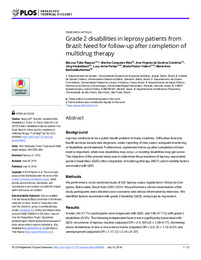Por favor, use este identificador para citar o enlazar este ítem:
https://hdl.handle.net/11000/30548Registro completo de metadatos
| Campo DC | Valor | Lengua/Idioma |
|---|---|---|
| dc.contributor.author | Raposo, Marcos Túlio | - |
| dc.contributor.author | Cerqueira Reis, Martha | - |
| dc.contributor.author | Caminha, Ana Virgínia de Queiroz | - |
| dc.contributor.author | Heukelbach, Jorg | - |
| dc.contributor.author | Parker, Lucy Anne | - |
| dc.contributor.author | Pastor-Valero, Maria | - |
| dc.contributor.author | Nemes, Maria Ines B | - |
| dc.contributor.other | Departamentos de la UMH::Salud Pública, Historia de la Ciencia y Ginecología | es_ES |
| dc.date.accessioned | 2024-01-22T17:36:30Z | - |
| dc.date.available | 2024-01-22T17:36:30Z | - |
| dc.date.created | 2018-06 | - |
| dc.identifier.citation | PLoS Negl Trop Dis 12(7) | es_ES |
| dc.identifier.issn | 1935-2735 | - |
| dc.identifier.issn | 1935-2727 | - |
| dc.identifier.uri | https://hdl.handle.net/11000/30548 | - |
| dc.description.abstract | Background Leprosy continues to be a public health problem in many countries. Difficulties faced by health services include late diagnosis, under-reporting of new cases, adequate monitoring of disabilities and treatment. Furthermore, systematic follow-up after completion of treatment is important, when new disabilities may occur, or existing disabilities may get worse. The objective of the present study was to determine the prevalence of leprosy-associated grade 2 disabilities (G2D) after completion of multidrug therapy (MDT) and to identify factors associated with G2D. Methods We performed a cross-sectional study of 222 leprosy cases registered in Vitória da Conquista, Bahia state, Brazil from 2001–2014. We performed a clinical examination of the study participants and collected socio-economic and clinical information by interview. We identified factors associated with grade 2 disability (G2D) using logis tic regression. Results In total, 38 (17.1%) participants were diagnosed with G2D, and 106 (47.7%) with grade 1 disabilities (G1D). The following independent factors were significantly associated with G2D: occurrence of leprosy reaction (adjusted OR = 2.5; 95%CI = 1.09–5.77), thickening and/or tenderness of one or more nerve trunks (adjusted OR = 3.0; CI = 1.13–8.01) and unemployment (adjusted OR = 7.17; CI = 2.44–21.07). Conclusions This study shows that physical disabilities remain after completion of MDT and frequently occur in an endemic area in Brazil. Finding new ways to reduce the burden of disability are urgently needed, and may include systematic follow-up of patients after treatment completion combined with evidence-based preventative measures. | es_ES |
| dc.format | application/pdf | es_ES |
| dc.format.extent | 12 | es_ES |
| dc.language.iso | eng | es_ES |
| dc.publisher | Public Library of Science | es_ES |
| dc.rights | info:eu-repo/semantics/openAccess | es_ES |
| dc.rights | Attribution-NonCommercial-NoDerivatives 4.0 Internacional | * |
| dc.rights.uri | http://creativecommons.org/licenses/by-nc-nd/4.0/ | * |
| dc.subject | Leprosy | es_ES |
| dc.subject | diagnosis | es_ES |
| dc.subject | factors associated with G2D | es_ES |
| dc.subject.other | CDU::6 - Ciencias aplicadas::61 - Medicina | es_ES |
| dc.title | Grade 2 disabilities in leprosy patients from Brazil: Need for follow-up after completion of multidrug therapy | es_ES |
| dc.type | info:eu-repo/semantics/article | es_ES |
| dc.relation.publisherversion | https://doi.org/10.1371/journal.pntd.0006645 | es_ES |

Ver/Abrir:
16-PLOS-negel Trp Dis-2018 (1).pdf
1,28 MB
Adobe PDF
Compartir:
 La licencia se describe como: Atribución-NonComercial-NoDerivada 4.0 Internacional.
La licencia se describe como: Atribución-NonComercial-NoDerivada 4.0 Internacional.
.png)